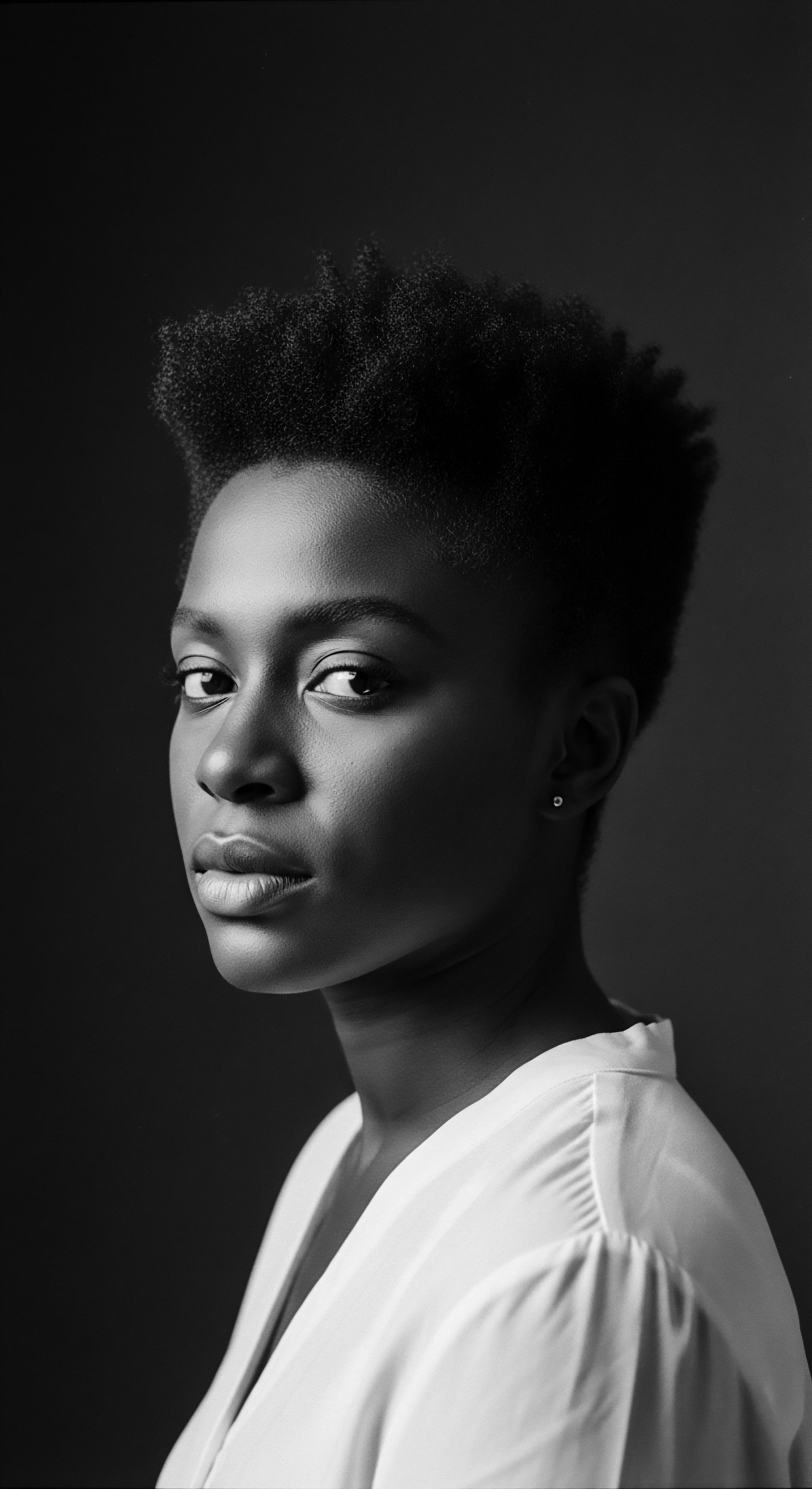
Fundamentals
The conversation surrounding hair, especially coily hair, often begins with admiration for its singular beauty, its remarkable ability to defy gravity, and its rich cultural resonance. Yet, underneath this outward celebration, an inherent delicacy exists, a whispered fragility that has long been recognized within ancestral traditions and is now affirmed by contemporary scientific observation. This delicate aspect, a susceptibility to certain environmental and mechanical stressors, constitutes what we might call the Coily Hair Vulnerability. It describes the natural predispositions and external pressures that render tightly coiled hair patterns more prone to specific challenges compared to other hair types.
To truly grasp this concept, we must begin at the strand’s primal source, its elemental biology. Coily hair, typically categorized as Type 4 in widely adopted hair typing systems, exhibits a unique helical formation, an exceptionally tight, spring-like structure. This distinctive shape, originating from a curved or hooked follicle, is what bestows upon coily hair its signature volume and texture. But this very geometry, a testament to genetic inheritance and evolutionary adaptation in diverse climates, introduces inherent physical characteristics that shape its care requirements.
The natural oils, known as sebum, produced by the scalp, struggle to descend the labyrinthine twists and turns of each individual strand. This resistance to oil migration means that coily hair is often intrinsically drier than straighter textures, a fundamental biological reality that lays the groundwork for its delicate disposition.
This primary dryness is a key component of its vulnerability, influencing how the hair interacts with moisture, or the lack thereof, in its environment. Think of a well-hydrated plant leaf; it bends, it sways, it offers gentle resistance. A parched leaf, by contrast, becomes brittle, stiff, and prone to splintering with the slightest provocation. Hair behaves in a similar fashion.
Without sufficient internal moisture, the outer cuticle layer, comprised of overlapping scales that protect the inner cortex, can become raised and susceptible to damage. This can lead to issues such as heightened friction, tangling, and ultimately, breakage.
Coily Hair Vulnerability refers to the innate susceptibility of tightly coiled strands to environmental and mechanical stressors, a characteristic rooted in its unique helical structure and inherent dryness.
Historically, communities with predominantly coily hair textures developed care practices that, without the benefit of modern microscopy or chemical analysis, intuitively addressed these foundational aspects. From the use of rich plant-based butters and oils, drawn from the earth’s bounty, to the practice of protective styling, these methods aimed to seal moisture, reduce manipulation, and safeguard the hair from the elements. These ancestral wisdoms represent the earliest forms of understanding and mitigating the challenges of coily hair, a testament to generations observing, learning, and adapting. This deep-seated knowledge, passed down through oral traditions and communal rituals, recognized the delicate balance required to maintain health and resilience within these unique hair forms.

The Curl’s Blueprint ❉ Anatomy of a Strand
Each coily hair fiber, though appearing robust in its collective mass, possesses an individual structure that reveals its intrinsic delicate nature. The outermost layer, the Cuticle, consists of overlapping scales, much like shingles on a roof. These scales lie flatter on straight hair, allowing for a smoother surface and easier distribution of natural oils. In contrast, coily hair often exhibits a more lifted cuticle, making it more porous and less effective at retaining internal moisture.
Below the cuticle resides the Cortex, the thickest part of the hair shaft, which contains keratin proteins responsible for the hair’s strength and elasticity. The specific arrangement and distribution of keratin within the elliptical cross-section of a coily strand contribute to its fragility; some research even suggests a “hollow” aspect at the core of these fibers, predisposing them to fracture.
The journey of natural oils from the scalp along the tight twists of coily strands is arduous. This physical reality means that, for many, the ends of the hair, being the oldest and most distant from the scalp’s nourishing sebum, often experience heightened dryness. Such dryness is not merely a superficial concern; it weakens the strand, making it susceptible to tangling and the formation of single-strand knots, diminutive yet vexing occurrences that compromise length retention. Understanding these inherent biological characteristics is the first step toward a heritage-informed approach to hair care, one that honors the genetic legacy while providing targeted nourishment.
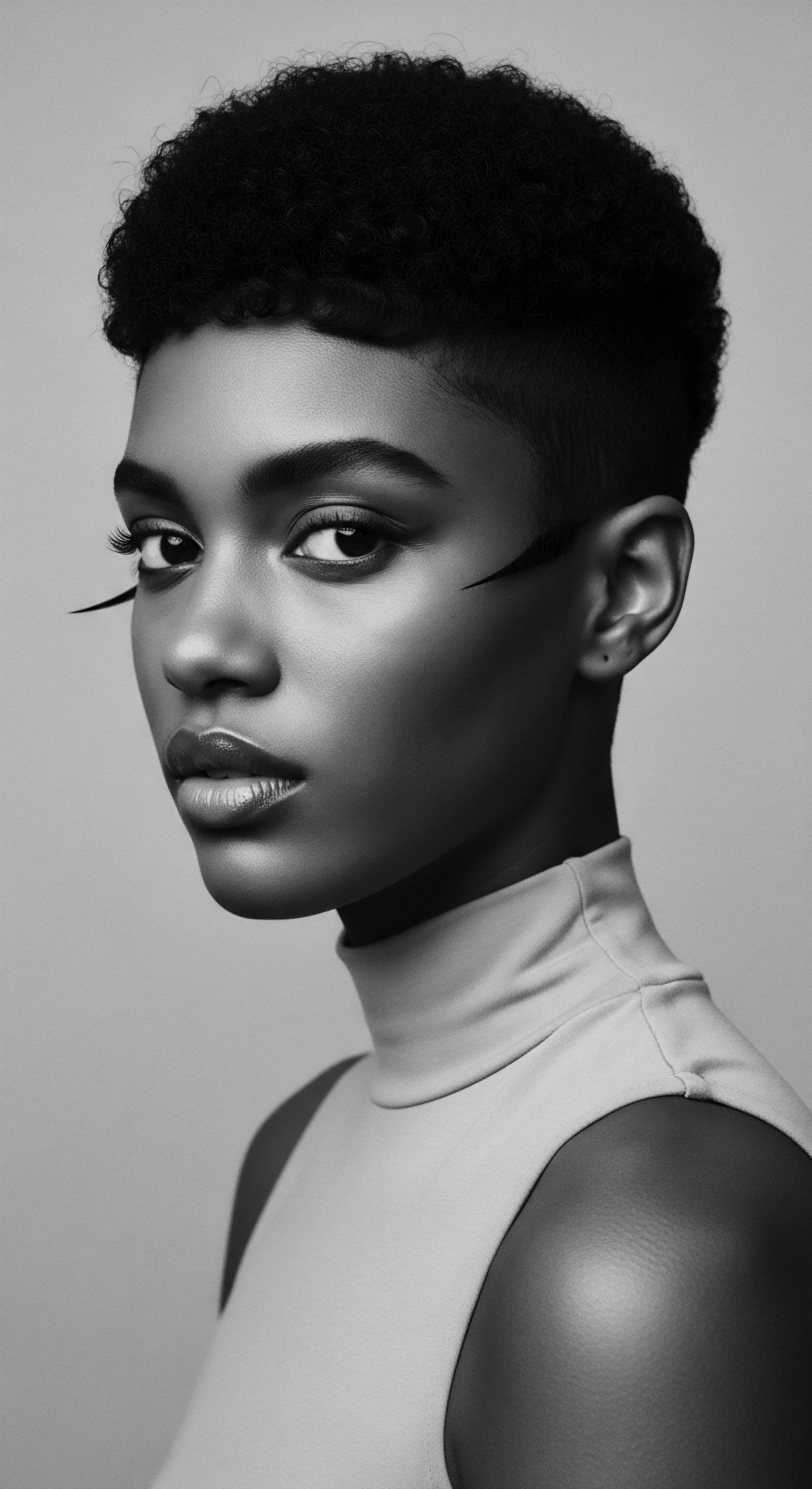
Intermediate
Moving beyond the basic biological predispositions, an intermediate understanding of Coily Hair Vulnerability delves into the interplay of these elemental factors with practical care and environmental conditions. This layer of comprehension recognizes that while the structure of coily hair presents certain challenges, daily practices and the external world significantly shape its true state of resilience or compromise. Here, we observe how ancestral wisdom, developed over centuries, provided a sophisticated, albeit unwritten, protocol for maintaining these delicate strands long before modern chemistry explained the underlying mechanisms.
The propensity for moisture loss, a fundamental aspect of coily hair’s inherent nature, necessitates a conscious and consistent approach to hydration. This understanding moves beyond merely applying water to involve a layered strategy of moisturizing and sealing. Ancestral communities, recognizing the dryness, instinctively turned to nature’s bounty.
Oils from various seeds and fruits, rich butters, and infused plant essences were not merely cosmetic additions; they served as vital emollients to supplement the hair’s natural oils and to create a protective barrier against the arid winds or sun’s intensity. This tradition of deep oiling and butter application, often performed with patient, ritualistic hands, speaks directly to countering the moisture retention challenges inherent to coily textures.
Historical hair practices for coily textures often provided intuitive solutions to inherent fragilities, demonstrating a profound ancestral comprehension of hair’s needs.
Moreover, the vulnerability of coily hair extends to its mechanical integrity. The very points where the hair bends in its tight helical configuration are areas of increased stress. Constant manipulation, aggressive detangling, or friction against abrasive surfaces can lead to micro-fractures, weakening the strand over time. This susceptibility to mechanical damage informed the development of protective styling across various African and diasporic communities.
Styles like braids, twists, and locs were not solely for aesthetic appeal or cultural signification; they served a crucial practical purpose ❉ minimizing daily handling, safeguarding the delicate ends, and preserving length. These styles, some passed down through millennia, represent a living archive of hair science, offering solutions that prioritize the hair’s structural wellbeing.

The Dance of Porosity and Protection
A deeper exploration into the science of hair porosity reveals why some coily textures absorb moisture readily yet struggle to retain it (high porosity), while others resist moisture penetration entirely (low porosity). These variations affect the optimal approach to care. For high porosity coily hair, which often has a more open cuticle, the challenge lies in sealing the moisture within the strand.
Traditional practices like the use of heavy butters and dense oils, or finishing styles with wraps, effectively created a physical barrier. For low porosity coily hair, which can appear shiny but feels dry due to its tightly bound cuticle, the wisdom centered on opening the cuticle gently to receive moisture, perhaps through steaming or warm oil applications.
The collective understanding that emerged from these observations, even without the language of “porosity” or “cuticle layers,” guided hair care decisions for generations. It manifested in specific rituals and ingredient selections, each chosen for its perceived ability to enhance the hair’s strength and vitality.
| Traditional Practice Deep Oiling & Buttering |
| Underlying Vulnerability Addressed Inherent dryness, moisture loss |
| Ancestral Ingredient/Tool Shea butter, Coconut oil, Palm oil, Chebe powder (mixed with oils) |
| Traditional Practice Protective Styling (Braids, Twists, Locs) |
| Underlying Vulnerability Addressed Mechanical fragility, breakage at bends |
| Ancestral Ingredient/Tool Combs, various threads, adornments |
| Traditional Practice Hair Threading (Irun Kiko) |
| Underlying Vulnerability Addressed Length retention, protective styling, temporary stretching |
| Ancestral Ingredient/Tool Cotton thread, specialized needles/fingers |
| Traditional Practice Headwraps & Adornments |
| Underlying Vulnerability Addressed Environmental protection (sun, dust), cultural expression |
| Ancestral Ingredient/Tool Fabrics (cotton, silk), cowrie shells, beads |
| Traditional Practice These practices, rooted in intimate knowledge of the hair and its environment, exemplify the ingenuity within diverse cultural lineages. |

The Weight of Shrinkage ❉ A Unique Challenge
Another aspect of coily hair’s unique disposition is its pronounced Shrinkage. While not a direct vulnerability in terms of damage, shrinkage can obscure the true length of the hair by as much as 75%. This characteristic, a testament to the hair’s elasticity and tight coiling, often creates a visual disparity between perceived and actual length. In ancestral contexts, techniques like African hair threading (Irun Kiko) were developed not only for protective styling but also to gently stretch the hair, showcasing its length while maintaining its health.
The ongoing contemporary natural hair movement continues to explore methods for managing shrinkage, honoring the hair’s natural state while allowing its full length to be appreciated. The wisdom of these historical methods underscores a long-standing dialogue with the hair’s intrinsic characteristics.
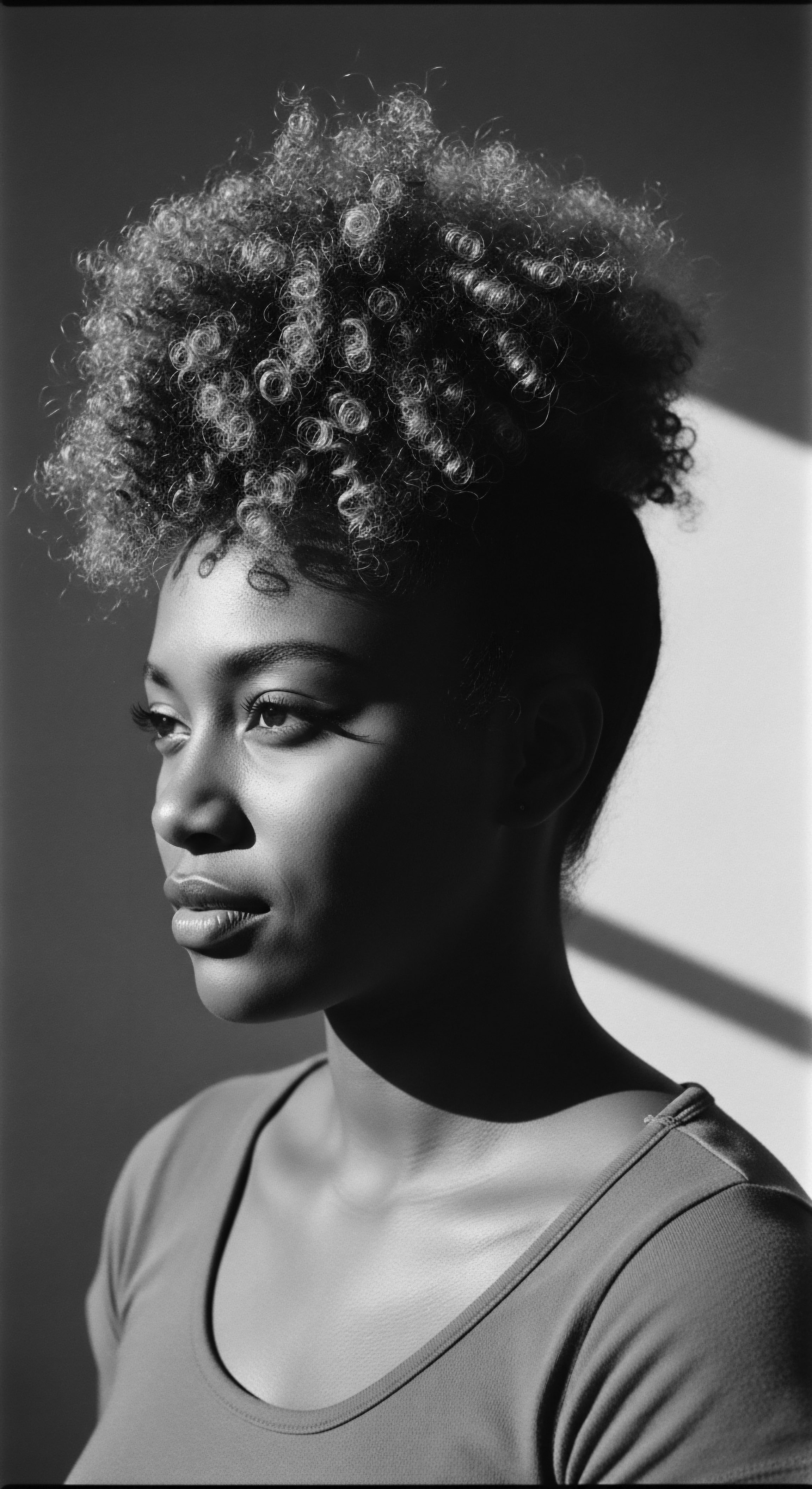
Academic
The Coily Hair Vulnerability represents a comprehensive, multi-layered construct, extending beyond mere biological predisposition to encompass socio-historical impositions and their psychological consequences. This advanced interpretation considers the intricate interplay of genetic heritage, environmental stressors, and the pervasive influence of cultural devaluation that have, across generations, shaped the experiences of individuals with tightly coiled hair. This exploration delves into the scientific specificity of these strands, simultaneously tracing the indelible imprints of historical adversity and celebrating the profound resilience woven into the very fabric of Black and mixed-race hair experiences.

Micro-Structural Specificities and Bio-Chemical Delicacy
From a microscopic standpoint, the elliptical or flattened cross-section of coily hair, originating from its curved follicle, yields a unique distribution of keratin proteins within the cortex. This asymmetrical deposition can lead to areas of structural weakness, predisposing the strand to fracture upon mechanical stress. The natural twists and turns of the coil itself represent points of mechanical fragility, where the hair shaft bends sharply, creating areas more susceptible to breakage under tension or manipulation.
Further, the cuticle, the hair’s outermost protective layer, tends to be more raised in coily textures compared to straighter hair. This open cuticle structure impacts Porosity, often rendering coily hair more prone to rapid moisture loss, a fundamental challenge in its upkeep.
The inherent dryness, a consequence of the scalp’s natural sebum struggling to navigate the hair’s intricate coils, compounds this fragility. Dry strands are brittle strands, less pliable, and more susceptible to damage during routine activities such as detangling or styling. Furthermore, the chemical composition of coily hair, while generally robust, faces specific threats.
The disulfide bonds, critical to the hair’s shape and strength, are permanently altered by chemical relaxers, a process historically employed to achieve straightened textures. This chemical manipulation, though offering a temporary aesthetic transformation, can compromise the hair’s integrity, leading to increased susceptibility to damage if not meticulously managed post-treatment.

The Imprint of History ❉ Socio-Cultural Stressors
The vulnerability of coily hair is not solely a matter of biology; it is profoundly shaped by centuries of socio-historical conditioning. The transatlantic slave trade marked a catastrophic rupture for African communities, severing individuals from their lands, languages, and, significantly, their hair traditions. The forced shaving of heads upon arrival in the Americas served as a deliberate act of dehumanization, a calculated effort to strip enslaved Africans of their identity and cultural lineage, effectively initiating the erasure of their deeply meaningful hair practices.
Subsequent colonial regimes and systems of oppression continued to devalue natural coiled textures, positioning Eurocentric hair standards as the benchmark of beauty and professionalism. The infamous Tignon Laws of 18th-century Louisiana stand as a stark example. These mandates compelled free Black women, whose elaborate natural hairstyles were perceived as too alluring and competitive with white women, to cover their hair with headwraps.
Yet, in an astonishing testament to resilience, these women transformed the headwrap into an art form, utilizing luxurious fabrics and inventive styles to reclaim agency and express dignity. This historical response embodies a profound understanding of coily hair’s dual vulnerability ❉ its natural delicacy and its enforced social burden.
The historical weaponization of hair texture created a de facto caste system, where individuals with looser curls or straighter hair were often granted preferential treatment, such as domestic labor, while those with kinky textures were relegated to harsher field work. This ingrained hierarchy propagated internal biases within Black communities, linking desirability and social acceptance to the approximation of white beauty standards, perpetuating the pressure to alter natural hair textures through painful and damaging methods like hot combs and chemical relaxers.
The historical devaluation of coily hair, rooted in colonial oppression, amplified its inherent fragilities, transforming natural textures into sites of social and psychological struggle.

A Narrative of Resilience ❉ Hiding Seeds in Strands
One compelling, yet often under-recognized, historical example that powerfully illustrates the intersection of Coily Hair Vulnerability and the enduring spirit of textured hair heritage lies in the clandestine practices of enslaved African women during the transatlantic passage. In the face of unimaginable adversity and profound dehumanization, these women ingeniously utilized their coiled hair as a living repository for survival. They braided precious seeds and grains—such as rice, okra, and millet—into their intricate cornrows before being forcibly transported from Africa. This practice, often performed during the harrowing journey or immediately upon arrival, allowed them to carry the genetic blueprints of their homeland’s agriculture and, by extension, a tangible piece of their heritage and future sustenance, literally woven into their very being.
This act held multiple layers of significance. Biologically, the dense, tightly coiled structure of African hair provided an ideal, secure hiding place, preventing the small seeds from dislodging during the brutal voyage. It was a natural, concealed vessel. Culturally, the practice continued the ancient tradition of hair as a sacred, personal space, a container of identity and ancestral knowledge, even when their bodies were enslaved and their external markers of identity stripped away.
This silent defiance transformed a biological characteristic, which colonial narratives sought to diminish, into a tool of resistance and survival. It underscored a deep, embodied knowledge of their hair’s protective capabilities, turning an intrinsic vulnerability into a covert strength. The very act of braiding, a communal and culturally significant practice in West Africa, became a covert act of preserving life and legacy.
This historical account provides a powerful counter-narrative to the idea of inherent weakness. Instead, it frames coily hair’s structure, even in its delicate nature, as a site of profound ingenuity and resistance. It demonstrates that the vulnerability of coily hair was not solely about its biological susceptibility to breakage but also about its exposure to systemic attempts at erasure. The act of hiding seeds in cornrows served as a testament to the ancestral understanding of hair as both a biological entity requiring care and a cultural symbol demanding protection and preservation.
This historical narrative, though less frequently highlighted in broader discussions of hair care, powerfully articulates the enduring connection between hair, heritage, and the unrelenting human spirit. (Essien, 2024).
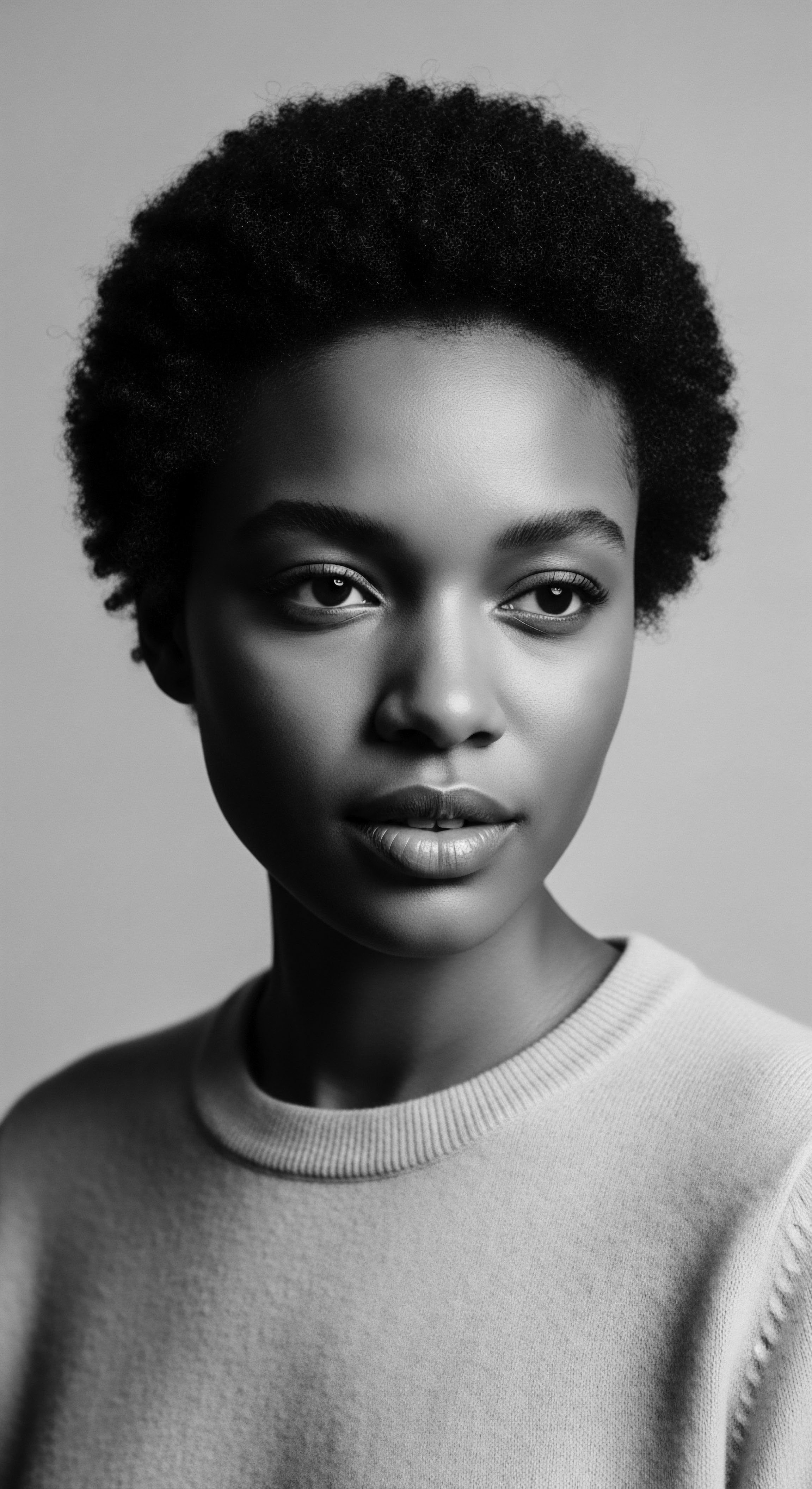
Psychological and Societal Ramifications
The Coily Hair Vulnerability extends into the psychological and social realms, creating enduring challenges for individuals in the African diaspora. The continuous exposure to negative stereotypes and societal pressures regarding natural hair contributes to significant mental and emotional burdens. Terms like “unprofessional,” “messy,” or “unruly,” frequently applied to coily textures in academic and professional settings, foster internalized racism and a diminished sense of self-worth.
Research indicates that discrimination based on hair texture is a pervasive reality. A study conducted by Dove in the UK, for example, revealed that Half of Black and Mixed Women with Afro-Textured Hair Have Faced Discrimination Because of Their Hair. This statistic underscores the lived experience of navigating spaces where one’s natural appearance is deemed unacceptable, leading to heightened anxiety, hypervigilance, and chronic stress. The constant pressure to conform, often resulting in chemically or heat-straightening hair, carries not only physical risks to the hair’s health but also profound psychological tolls, impacting self-confidence and identity.
The development of the CROWN Act (Creating a Respectful and Open World for Natural Hair) in the United States represents a contemporary legislative effort to address this historical and ongoing discrimination. Such legal protections acknowledge that hair is an integral aspect of racial identity and that discrimination against natural hair constitutes racial discrimination. These movements reflect a collective awakening to the deep psychological scars left by generations of hair-based prejudice and a determination to reclaim self-acceptance and pride.
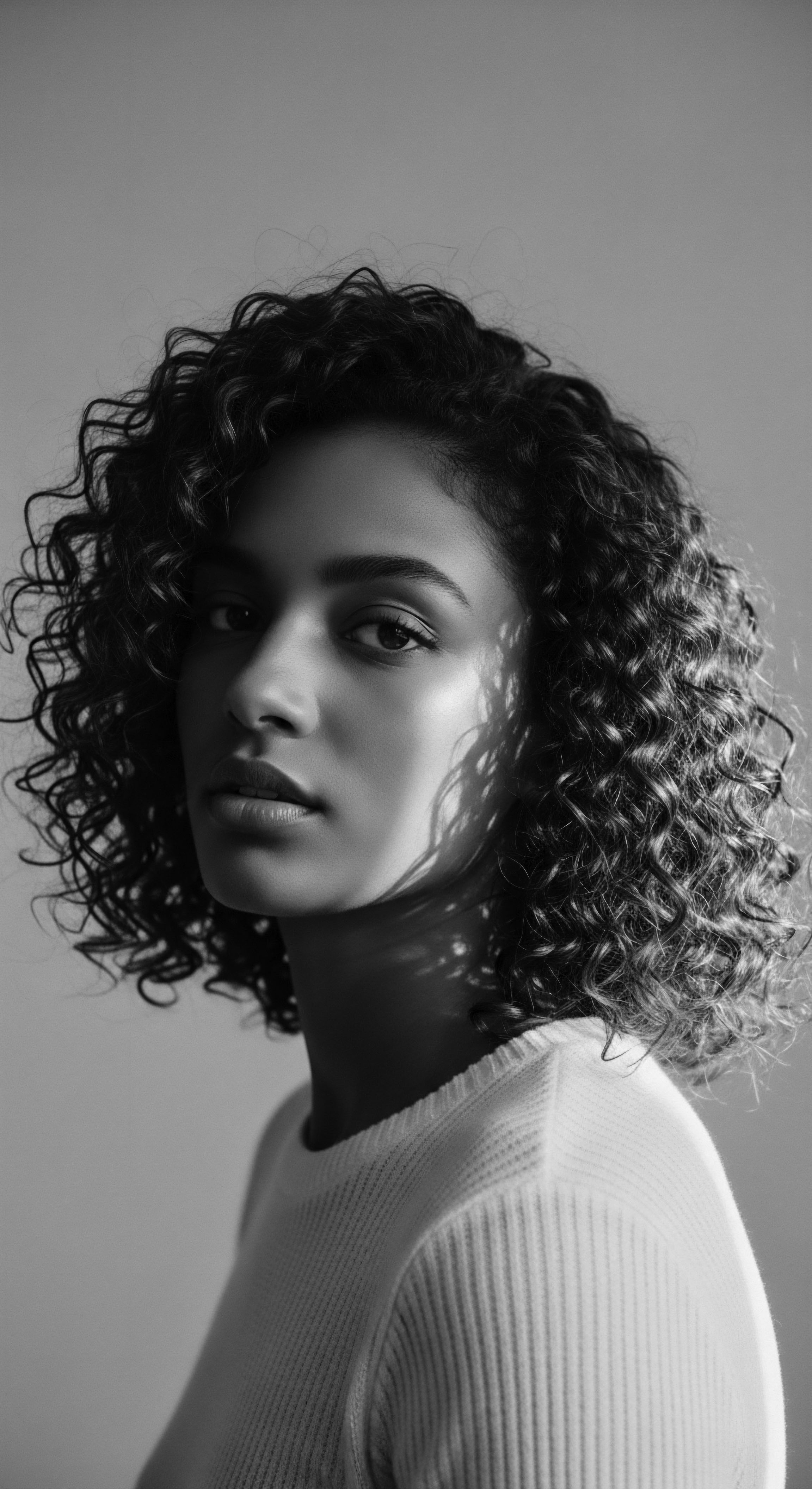
Interconnected Incidences and Long-Term Insights
The scope of Coily Hair Vulnerability broadens to reveal interconnected incidences across various societal sectors. Economically, individuals with coily hair often face higher expenditures on specialized products designed to address their hair’s unique moisture and styling needs. The hair care industry, while increasingly acknowledging textured hair, has historically profited from practices that encouraged alteration rather than celebration of natural coils. Socially, the pressure to conform can affect educational opportunities and career advancement, as evidenced by instances of Black individuals being denied jobs or sent home from school due to their natural hairstyles.
The insights derived from this comprehensive understanding point toward a future rooted in advocacy, education, and holistic care.
- Policy Advocacy ❉ Legislation similar to the CROWN Act is vital to dismantle systemic hair discrimination, ensuring equitable access to opportunities without pressure to alter natural hair.
- Hair Science Education ❉ Disseminating accurate information about the unique structure and needs of coily hair aids in debunking myths and promoting practices that prioritize hair health over conformity.
- Cultural Reaffirmation ❉ Continued celebration of traditional hairstyles and ancestral care practices strengthens cultural identity, fostering self-acceptance and pride in one’s heritage.
- Psychological Wellness ❉ Addressing the mental health implications of hair discrimination through support networks, culturally competent therapy, and media representation helps heal collective and individual trauma.
The enduring legacy of Coily Hair Vulnerability is not one of inherent defect, but rather a profound testament to systemic challenges and the enduring spirit of adaptation and resistance. The journey toward a more respectful and knowledgeable world for textured hair continues, guided by the wisdom of the past and the illumination of contemporary understanding.
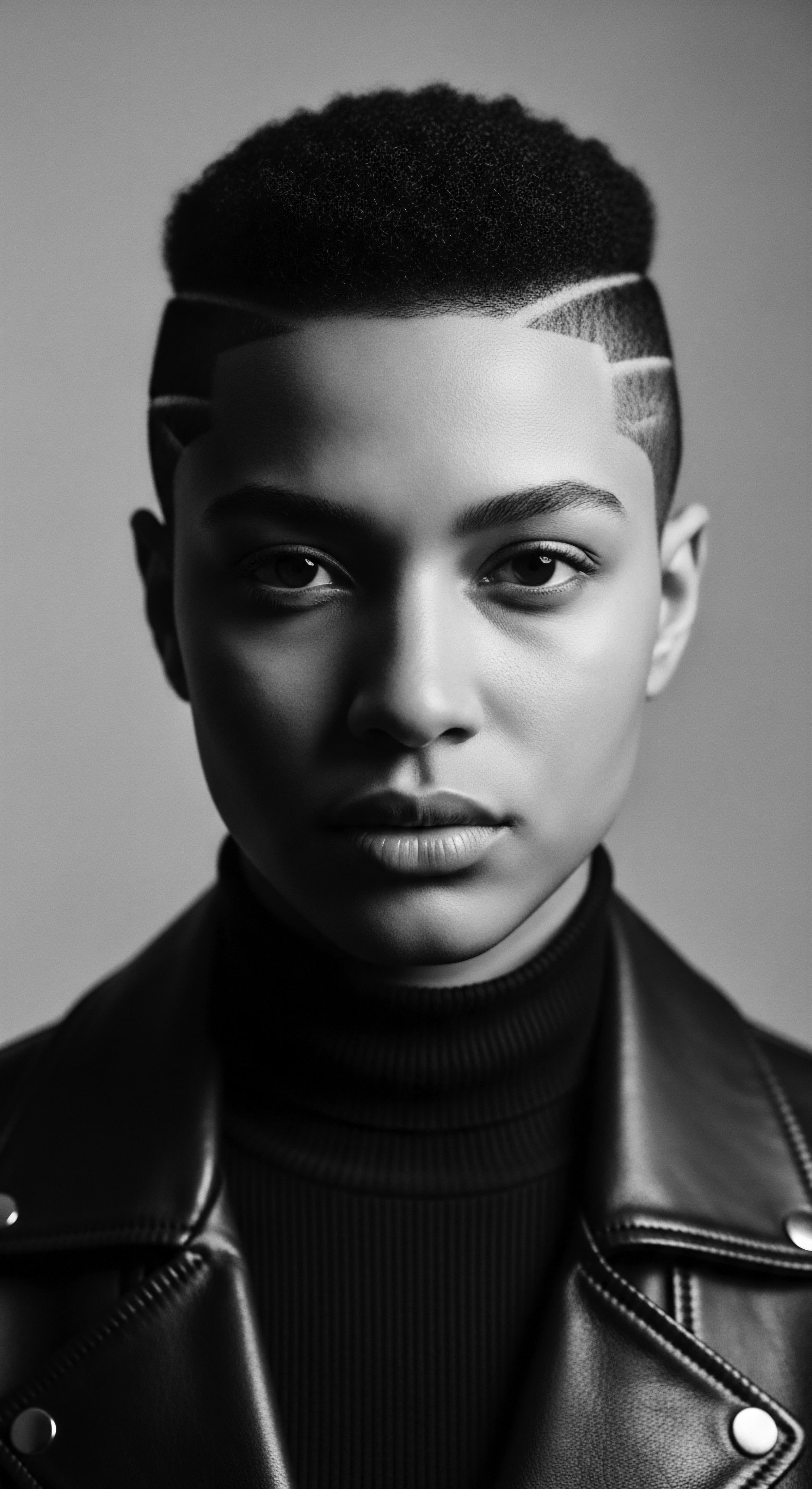
Reflection on the Heritage of Coily Hair Vulnerability
As we draw this meditation to its close, the understanding of Coily Hair Vulnerability transcends a simple scientific exposition or a historical recounting. It transforms into a living narrative, a profound testament to the enduring spirit deeply rooted in the textured hair legacy of Black and mixed-race communities. The concept, initially presenting as a mere biological reality of susceptibility, unfurls to reveal layers of cultural meaning, historical resilience, and an unbroken lineage of intimate care.
From the echoes of ancient African hearths, where hair was revered as a sacred conduit and an archive of lineage, we discern the earliest forms of wisdom against its delicate nature. The hands that braided, oiled, and adorned these coils were not merely styling; they were practicing a holistic wellness, preserving a heritage, and performing acts of reverence for the self and the community. This deep, ancestral comprehension of hair’s needs speaks volumes, demonstrating that generations intuitively grasped the balance required to protect what was inherently precious. They saw the vulnerability, not as a defect, but as a call for intentional, tender care, a truth passed through touch and tradition.
The true strength of coily hair resides not in an absence of vulnerability, but in the unwavering ancestral wisdom and enduring resilience cultivated through centuries of intentional care and cultural affirmation.
The journey through periods of forced displacement and systemic devaluation added formidable layers to this vulnerability, transforming personal beauty into a site of struggle and resistance. Yet, in defiance, ingenuity blossomed. The very textures that oppressors sought to diminish became canvases for silent rebellion, sanctuaries for survival, and powerful declarations of identity. The Coily Hair Vulnerability, therefore, encompasses not only the hair’s intrinsic predispositions but also the compounded societal burdens placed upon it.
Today, as scientific inquiry aligns with traditional understanding, we witness a renaissance of appreciation for coily hair in its unadulterated state. This modern re-affirmation, built upon the bedrock of ancestral practices, invites a renewed commitment to intentional care. It is a call to honor the biological specificities of these strands with hydrating rituals, gentle handling, and protective styles, acknowledging the scientific basis for practices that have sustained coiled hair through centuries. It also serves as a potent reminder of the cultural significance of hair—its profound connection to identity, self-love, and community.
The path forward for coily hair recognizes that its unique characteristics, its very vulnerabilities, have, through time and enduring spirit, made it a symbol of strength, creativity, and an unyielding connection to a rich, living heritage. The unbound helix continues its story, each coil a testament to a legacy of beauty, tenacity, and wisdom.

References
- Afiya, M. (2020). Hair, Trauma, and Resistance ❉ A Psychology of Black Hair. Journal of Black Psychology, 46(1), 3-21.
- Byrd, A. D. & Tharps, L. D. (2001). Hair Story ❉ Untangling the Roots of Black Hair in America. St. Martin’s Press.
- Chaudhuri, M. (2018). The Structure of Keratin and Hair Follicles ❉ Implications for Hair Fragility. Biomedical Research Press.
- Essien, I. (2024). OverSeeding ❉ Botanical Knowledge and Cultural Resistance in the African Diaspora. Blackwood Gallery Exhibitions.
- Johnson, R. & Bankhead, T. (2014). Hair It Is ❉ Examining the Experiences of Black Women with Natural Hair. Sociology of Race and Ethnicity, 1(1), 136-152.
- Marsh, D. (2015). African Hair ❉ Its Cultural and Historical Significance. University of California Press.
- Perez, M. et al. (2022). Negative Experiences Related to Hair are Normative for Young Black Girls. Body Image, 42, 230-239.
- Scott, E. (2019). Hair and Justice ❉ Decoding Black Hair Discrimination in the Workplace. Law and Society Review.
- Smith, T. (2021). The Science of Coily Hair ❉ Moisture, Porosity, and Care Protocols. Cosmetology Research Institute.
- Tatum, B. D. (1997). “Why Are All the Black Kids Sitting Together in the Cafeteria?” ❉ And Other Conversations About Race. Basic Books.
- Walker, R. (2017). The Chemistry of Hair Relaxers ❉ Disulfide Bonds and Structural Changes. Journal of Chemical Education.
